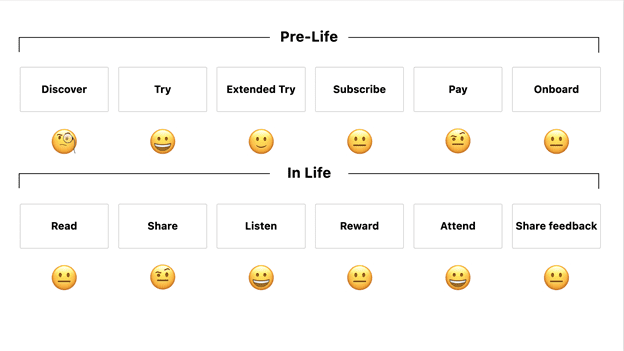|
Getting your Trinity Audio player ready...
|
The Spectator is a weekly British magazine covering politics, culture, and geopolitical affairs, who first began producing content in 1828, and is now considered the world’s longest-standing weekly magazine. With nearly 200 years of rich tradition, the publication has a history of producing in-depth, engaging content, which remains a core philosophy.
The magazine has long been distributed in print format across the UK and later introduced online distribution for the UK, Australia, and the United States. But in 2016, they tightened up their metered paywall, reducing the amount of content that was available for free. Today, they offer a few free articles per month before inviting people to become subscribers and access even more high-quality content.
In 2019, Tom Morgan joined The Spectator as Director of Digital. Under Morgan’s direction, the title created a unique intersection that bridged the creative process, the marketing, and the tech used to bring it all together so the reader received an engaging experience on the website front end.
“Any kind of new technology with us would always be set against the backdrop of the ways we work and the approaches and processes that go back a long time,” says Morgan, adding, “Something I don’t think has changed between 1828 and now is the concept of family. We, as a magazine, right through to the digital users we have today, understand that idea.”
Understanding the whole customer journey
To optimise their users’ digital experiences, The Spectator began by focusing on the basics of delivering quality content – the digital team at The Spectator strived to “become their users”, in which they attempted to picture their customers and build experiences that appealed to them. They also conducted multiple on-site user workshops, and found that users understood and were appreciative of the magazine’s editorial philosophy.
These insights shaped how the website was overhauled to maximise the value of the subscription experience. The digital team created a simple blueprint to outline the key areas of the customer journey that should be focused on.

“We identified the subscription and pay journeys as really important,” Morgan says. “And of course, reading was the other thing that really stood out for our readers, and that was fundamentally why we decided to redesign our entire website.”
It’s also the reason why The Spectator removed programmatic advertising from its website — because it interfered with creating a quality user experience. The team also adopted a “less is more” approach to onsite ads, reserving space for only the highest-quality ads that would benefit users, while also improving the readability of the content.
Creating a good product that people love
“There is a unique intersection between our creative process, the marketing side of the business, and the technology,” says Morgan. “The way that we bring those three together for people to actually use is through our products.”
“The key to loyalty is actually not particularly complicated,” Morgan continued. “You have to just create a really good product that you’re proud of, and furthermore, that people really love to use.”

The Spectator simultaneously overhauled its checkout flow, reduced the number of checkout fields, integrated every common payment option, and built login, logout, and registration options into one seamless flow.
The technology used to redevelop the experience was powered by Piano. With Piano deployed, The Spectator was able to overhaul the entire checkout process in six weeks, dramatically faster than the six months it took to create their previous checkout flow. Checkout completion time dropped from 90 seconds down to 30 seconds. Users liked the faster turnaround time and, as a result, conversion rates improved markedly. It was an early win that validated their focus on the basics and resulted in a significant increase in conversion wins and customer satisfaction.
“Now that we’ve got Piano deployed, we can offer far more personalised and quicker checkout experiences,” says Morgan. “We’re able to convert faster, we’re able to personalise better, and ultimately we’re able to create a better experience for our customers along the way.”
Growing the sense of loyalty and membership
With the brand identity cemented, and an improved website experience ready to deploy, it was time for The Spectator to apply those customer insights to real-time site activity. It’s vital to understand your users, but Morgan advocates going beyond understanding to actually become them.
“The reason this is important is because a lot of publishers are quite old. When you join an organisation that has a long history, it’s also got its own culture,” he explains. “And if you’re going to succeed in continuing that journey — and moreover, changing it and revolutionising it and pushing it in a new direction — you’re going to need to understand who those people are incredibly well.”
The goal is not to draw up a long wish list of what customers want, he cautioned.
“The single purpose of this exercise is to picture them when you’re building a product, is to think of them when you’re taking control of a marketing campaign. It’s about being humble and understanding what we might think is important from a business point of view is very different to the actual users who are engaging with the product. They’ve got to be central.”
Before redesigning the web site or implementing any of these changes, Morgan said it was important the team understood the three main things their readers came to The Spectator for:
- Perspective.
- Enjoyment.
- Belonging.
“I firmly believe that if you don’t know this stuff, it is impossible to build good digital products,” Morgan said. “Every decision you make inside a business must always come back to what you’re doing for your readers.”
Once you have this knowledge and insight, you can then use it to translate into the product.
“We use what we know about our users and what we know about our print product, and we bring them together to create [digital products] that are visually appealing.”
Piano provided out-of-the-box templates and segments that enabled The Spectator’s digital team to create customer journeys at speed that successfully grew the digital part of the business. The most important factor in selecting Piano was the flexibility of the tool and its ability to grow with the business.
“We rely on the Piano platform because it is both powerful and flexible so we can react and immediately improve and test the experience for our customers,” says Morgan.
David Gosen, Chief Revenue Officer, Piano, comments, “By delivering a value exchange based on the deep understanding of their audience, The Spectator have built not only a great and engaging magazine but have laid the foundation for future data-driven innovation and editorially-driven loyalty that will future-proof their business model based on registrations and subscriptions.
“Subscription business models and advertising revenue growth don’t need to be mutually exclusive; with the right strategy, publishers can run both a successful subscription business and a successful advertising business, while adding value to the overall reader experience.”
Achieving new subscription highs
During a three-month period, conversions at The Spectator more than doubled and the number of users exposed to their site continued to increase. Additionally, through the use of Piano’s end-to-end subscription solution, the publishing team saved significant time and resources in managing the website.
By segmenting their audience, The Spectator can now showcase offers tailored to subscription status. As they approach the end of 2020, the title is forecasting a milestone of 100,000 subscribers early next year, an achievement they will continue to expand upon.
“Our digital subscription offering is so much more than web. It’s emails, it’s podcasts, it’s events, it’s even continued appreciation of print. The Spectator is a highly omnichannel experience,” says Morgan. “We plan to use Piano as not just a tech platform, but to continue optimising the entire experience for our readers, improving customer journeys, and to help drive that cross-channel engagement.”

The Spectator Editor Fraser Nelson adds, “Sales of The Spectator are at a 192-year high, thanks to our website. Readers might come to read one article, then stay for another: on average, subscribers read between three and four articles every time they visit the website. It was overdue an upgrade, and in Tom Morgan we have found a digital director who has created a website that looks as good as the magazine itself. Far faster, more intuitive and with fewer adverts, it puts the reader first. We will also give a better showing to our podcasts, four of which are in the UK top 100, and our many events.”
“In creating the new website, we sampled the DNA of the first Spectator, produced by Joseph Addison for the coffee houses. I’ve written about the lessons we’ve drawn from it, and how our past has been the guide to our future. Addison wanted to show that, even though the embers of the Civil War were still warm, decent people could disagree with each other through rigour and humour. In a partisan age, his magazine was unpartisan – as Alexander Chancellor put it, The Spectator is more of a cocktail party than a political party. With our new website, there has never been a better time to join that party.”
“Digital is not a threat to print. In our experience, digital means our print sales are the highest they have ever been.”
Fraser Nelson, Editor, The Spectator



